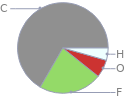Input interpretation

2-(trifluoromethyl)benzhydrol | elemental composition
Result

Find the elemental composition for 2-(trifluoromethyl)benzhydrol in terms of the atom and mass percents: atom percent = N_i/N_atoms × 100% mass percent = (N_im_i)/m × 100% Plan: • Write the chemical formula and gather atomic masses from the periodic table. • Determine values for N_i, m_i, N_atoms and m using these items. • Finally, compute the percents and check the results. Write the chemical formula: CF_3C_6H_4CH(OH)C_6H_5 Use the chemical formula to count the number of atoms, N_i, for each element and find the total number of atoms, N_atoms, per molecule: | number of atoms C (carbon) | 14 F (fluorine) | 3 H (hydrogen) | 11 O (oxygen) | 1 N_atoms = 14 + 3 + 11 + 1 = 29 Divide each N_i by N_atoms to calculate atom fractions. Then use the property that atom fractions must sum to one to check the work: | number of atoms | atom fraction C (carbon) | 14 | 14/29 F (fluorine) | 3 | 3/29 H (hydrogen) | 11 | 11/29 O (oxygen) | 1 | 1/29 Check: 14/29 + 3/29 + 11/29 + 1/29 = 1 Compute atom percents using the atom fractions: | number of atoms | atom percent C (carbon) | 14 | 14/29 × 100% = 48.3% F (fluorine) | 3 | 3/29 × 100% = 10.3% H (hydrogen) | 11 | 11/29 × 100% = 37.9% O (oxygen) | 1 | 1/29 × 100% = 3.45% Look up the atomic mass, m_i, in unified atomic mass units, u, for each element in the periodic table: | number of atoms | atom percent | atomic mass/u C (carbon) | 14 | 48.3% | 12.011 F (fluorine) | 3 | 10.3% | 18.998403163 H (hydrogen) | 11 | 37.9% | 1.008 O (oxygen) | 1 | 3.45% | 15.999 Multiply N_i by m_i to compute the mass for each element. Then sum those values to compute the molecular mass, m: | number of atoms | atom percent | atomic mass/u | mass/u C (carbon) | 14 | 48.3% | 12.011 | 14 × 12.011 = 168.154 F (fluorine) | 3 | 10.3% | 18.998403163 | 3 × 18.998403163 = 56.995209489 H (hydrogen) | 11 | 37.9% | 1.008 | 11 × 1.008 = 11.088 O (oxygen) | 1 | 3.45% | 15.999 | 1 × 15.999 = 15.999 m = 168.154 u + 56.995209489 u + 11.088 u + 15.999 u = 252.236209489 u Divide the mass for each element by m to calculate mass fractions. Then use the property that mass fractions must sum to one to check the work: | number of atoms | atom percent | mass fraction C (carbon) | 14 | 48.3% | 168.154/252.236209489 F (fluorine) | 3 | 10.3% | 56.995209489/252.236209489 H (hydrogen) | 11 | 37.9% | 11.088/252.236209489 O (oxygen) | 1 | 3.45% | 15.999/252.236209489 Check: 168.154/252.236209489 + 56.995209489/252.236209489 + 11.088/252.236209489 + 15.999/252.236209489 = 1 Compute mass percents using the mass fractions: Answer: | | | number of atoms | atom percent | mass percent C (carbon) | 14 | 48.3% | 168.154/252.236209489 × 100% = 66.67% F (fluorine) | 3 | 10.3% | 56.995209489/252.236209489 × 100% = 22.60% H (hydrogen) | 11 | 37.9% | 11.088/252.236209489 × 100% = 4.396% O (oxygen) | 1 | 3.45% | 15.999/252.236209489 × 100% = 6.343%
Mass fraction pie chart

Mass fraction pie chart